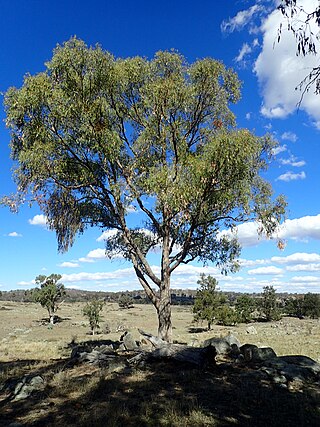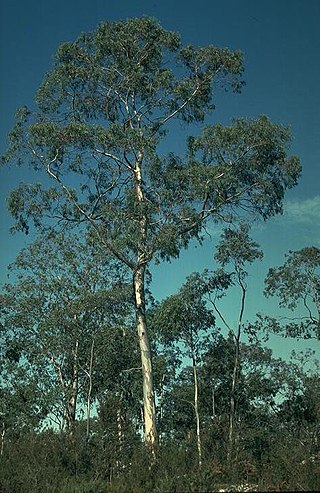
Eucalyptus gunnii, commonly known as cider gum, is a species of large tree in the flowering plant family Myrtaceae. It is endemic to the island of Tasmania, Australia. It has mostly smooth bark, lance-shaped to egg-shaped adult leaves, flower buds in groups of three, white flowers and cylindrical to barrel-shaped fruit.

Eucalyptus melanophloia, commonly known as silver-leaved ironbark, is a species of tree that is endemic to northeastern Australia. It is a small to medium-sized tree with rough, hard ironbark on the trunk and branches. The crown is usually composed of juvenile leaves that are dull, glaucous, sessile and arranged in opposite pairs. The flower buds are arranged in groups of seven, the flowers white and the fruit cup-shaped to hemispherical.

Eucalyptus morrisbyi, commonly known as Morrisby's gum, is a species of small to medium-sized tree that is endemic to a restricted area of Tasmania. It has loose slabs of rough bark near the base of its trunk, smooth pale grey bark above, lance-shaped to egg-shaped adult leaves, flower buds in groups of three, white flowers and barrel-shaped or cylindrical fruit. It is only known in the wild from a few small populations but has been widely planted as an ornamental.

Eucalyptus macrocarpa, commonly known as mottlecah, is a species of mallee that is endemic to the south-west of Western Australia. It has smooth bark, usually sessile, heart-shaped adult leaves arranged in opposite pairs, large red flowers and broad conical fruit.

Eucalyptus nova-anglica, commonly known as the New England peppermint or black peppermint, is a species of small to medium-sized tree endemic to eastern Australia. It has thick, rough, fibrous bark on the trunk and larger branches, lance-shaped adult leaves, flower buds in groups of seven, white flowers and hemispherical or conical fruit.

Eucalyptus radiata, commonly known as the narrow-leaved peppermint or Forth River peppermint, is a species of tree that is endemic to south-eastern Australia. It has rough, fibrous to flaky bark on the trunk and larger branches, smooth grey bark on the thinner branches, lance-shaped to curved or almost linear leaves, flower buds in groups of eleven to twenty or more, white flowers and cup-shaped, hemispherical or shortened spherical fruit.

Eucalyptus cinerea, commonly known as the Argyle apple, mealy stringbark or silver dollar tree, is a species of small- to medium-sized tree that is endemic to south-eastern Australia. It has rough, fibrous bark on the trunk and branches, usually only juvenile, glaucous, egg-shaped evergreen leaves, flower buds in groups of three, white flowers and conical to bell-shaped fruit.

Eucalyptus cordata, commonly known as the heart-leaved silver gum is a shrub to medium-sized tree that is endemic to Tasmania. It has smooth bark throughout, mostly only juvenile, more or less heart-shaped, glaucous leaves, glaucous flower buds arranged in groups of three, white flowers and cylindrical or hemispherical fruit.

Eucalyptus pulverulenta, commonly known as silver-leaved mountain gum, is a species of straggly tree or mallee that is endemic to southern New South Wales. It has smooth bark, egg-shaped, heart-shaped or round, sessile leaves arranged in opposite pairs, flower buds in groups of three, white flowers and cup-shaped to cylindrical fruit.

Eucalyptus coccifera, commonly known as the Tasmanian snow gum, is a small to medium-sized tree in the Eucalyptus genus, endemic to Tasmania. It has smooth, grey and cream-coloured bark, elliptic to lance-shaped adult leaves, flower buds in groups of between three and nine, usually white flowers and conical, hemispherical or cup-shaped fruit.

Eucalyptus vernicosa, commonly known as varnished gum, is a species of shrub or a mallee that is endemic to mountainous areas of Tasmania. It has smooth greyish bark, crowded, egg-shaped to elliptical or round leaves, flower buds singly or in groups of three in leaf axils, white flowers and hemispherical or bell-shaped fruit.

Eucalyptus cephalocarpa, commonly known as mealy stringybark or silver stringybark is a species of small to medium-sized tree, that is endemic to south-eastern Australia. It has rough, fibrous bark on the trunk and branches, lance-shaped adult leaves, Flower buds arranged in groups of seven, white flowers and conical, bell-shaped or hemispherical fruit.

Eucalyptus nitida, commonly known as the Smithton peppermint, is a species of tree or mallee that is endemic to Tasmania. It has varying amounts of loose, fibrous or flaky bark, lance-shaped to curved adult leaves, flower buds in groups of nine to fifteen, white flowers and cup-shaped to hemispherical fruit.

Eucalyptus tenuiramis, commonly known as the silver peppermint, is a species of small to medium-sized tree that is endemic to southeastern Tasmania. It has smooth bark, broadly lance-shaped adult leaves, flower buds in groups of nine to fifteen, white flowers and cup-shaped, hemispherical or conical fruit.
Eucalyptus elaeophloia, commonly known as Nunniong gum or olive mallee, is a species of tree or mallee that is endemic to a restricted area in Victoria. It has mostly smooth greenish to greyish bark, glossy green, lance-shaped adult leaves, flower buds in groups of three, white flowers and conical or hemispherical fruit.

Eucalyptus falciformis, commonly known as the Grampians peppermint or western peppermint, is a species of tree or mallee that is endemic to south eastern Australia. It has smooth bark, sometimes with rough, fibrous bark at the base, narrow lance-shaped to egg-shaped or curved adult leaves, flower buds in groups of eleven to twenty one, white flowers and cup-shaped to shortly cylindrical fruit.

Eucalyptus urnigera, commonly known as urn tree, is a species of small to medium-sized tree that is endemic to Tasmania. It has smooth bark, lance-shaped or elliptical leaves, flower buds in groups of three, white flowers and urn-shaped fruit.

Eucalyptus globulus subsp. globulus, commonly known as the Tasmanian blue gum, southern blue gum, or blue gum, is a subspecies of tree that is endemic to southeastern Australia. It has mostly smooth bark with some persistent slabs of old bark at the base, juvenile leaves with one glaucous side, glossy, lance-shaped adult leaves, warty flower buds arranged singly in leaf axils, white flowers and hemispherical to conical fruit that is more or less square in cross-section.
Eucalyptus nebulosa, commonly known as the serpentine peppermint, is a species of small tree that is endemic to the northwest of Tasmania. It has smooth, creamy white bark, narrow elliptic adult leaves, flower buds usually arranged in groups of between seven and eleven, pale creamy white flowers and hemispherical or more or less top-shaped fruit.
Eucalyptus rodwayi, commonly known as the swamp peppermint, is a species of small to medium-sized tree that is endemic to Tasmania. It has rough, fibrous to flaky bark on the trunk and branches, narrow lance-shaped adult leaves, flower buds in groups of between seven and eleven, white flowers and conical to hemispherical fruit.


















